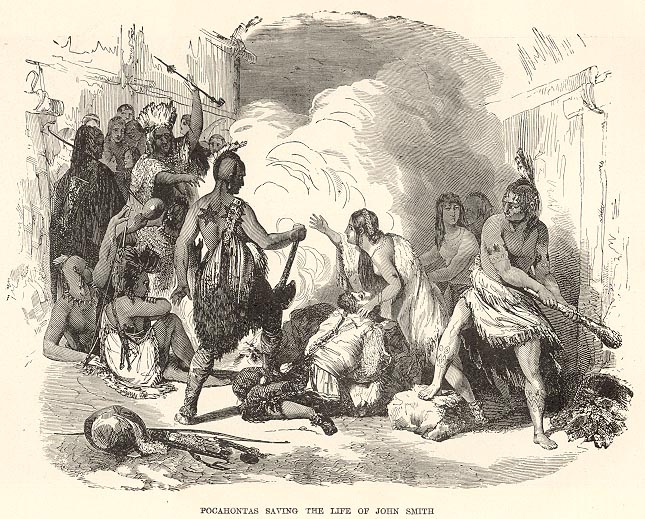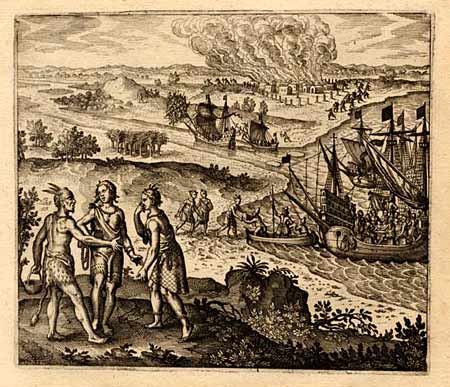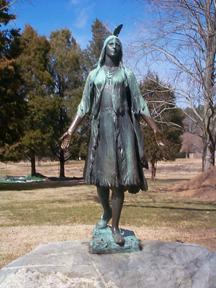
This portrait of Captain John Smith appeared on a 1616 map of New
England. The image is colorized by Jamie May from an original engraving
by Simon de Passe.
Virginians know that Captain John Smith was one of the first American heroes. But because he was a proud and boastful man, it is difficult to know which parts of his life are fact and which are fiction. What many people may not know is that Smith's adventures started even before Jamestown.
Born in 1580 in Willoughby, England, John Smith left home at age 16 after his father died. He began his travels by joining volunteers in France who were fighting for Dutch independence from Spain. Two years later, he set off for the Mediterranean Sea, working on a merchant ship. In 1600 he joined Austrian forces to fight the Turks in the "Long War." A valiant soldier, he was promoted to Captain while fighting in Hungary. He was fighting in Transylvania two years later in 1602. There he was wounded in battle, captured, and sold as a slave to a Turk. This Turk then sent Smith as a gift to his sweetheart in Istanbul. According to Smith, this girl fell in love with him and sent him to her brother to get training for Turkish imperial service. Smith reportedly escaped by murdering the brother and returned to Transylvania by fleeing through Russia and Poland. After being released from service and receiving a large reward, he traveled all through Europe and Northern Africa. He returned to England in the winter of 1604-05.
Here begins Captain John Smith's American adventures. Apparently restless in England, Smith became actively involved with plans to colonize Virginia for profit by the Virginia Company, which had been granted a charter from King James I. After setting sail on December 20, 1606, this famous expedition finally reached Virginia in April 1607 after enduring a lengthy voyage of over four months in three tiny ships. When the sealed box that listed the names of the seven council members who were to govern the colony was opened, Smith's name was on the list. On May 13, 1607 the settlers landed at Jamestown ready to begin the task of surviving in a new environment.
The harsh winter, lack of fresh water, and the spread of disease made life in Jamestown difficult for the settlers. Attacks by the native Algonquian Indians made life almost impossible. The Indians, hoping that the settlers would give up and leave, raided their camps, stealing pistols, gunpowder, and other necessary supplies. John Smith became leader of the colonists and did his best to fight off the Indians.

In December 1607, he and some companions were ambushed by Indian deer hunters. After killing the other Englishmen with him, the Indians carried Smith back to their powerful chief, Powhatan, to decide his fate. Powhatan was apparently greatly impressed by Smith's self-confidence as well as such mystical instruments as an ivory and glass pocket compass he carried with him. Smith was questioned about his colony and then made to take part in some sort of ritual or trial, after which, in keeping with an Indian custom, he was made a subordinate chief in the tribe. Powhatan's 11 year old daughter took part in the ceremony in some way. Smith was constantly unsure of his fate, and he was convinced afterward that Pocahontas had saved his life. Smith was released in friendship after about four weeks of captivity and returned to Jamestown, guided by Indians. Meanwhile, dissent within the colony fermented due to lack of supplies, laziness, and periodic attempts at desertion by many of the colonists, and personal conflicts among Smith and various leaders, as well as disagreements over new policies being formulated in London. As a result, Smith left Jamestown to explore and map the Chesapeake Bay region and search for badly needed food supplies. Due to bad government and near chaos, Smith was eventually elected president of the local council in September 1608. He instituted a policy of rigid discipline, strengthened defenses, and encouraged farming with this admonishment: "He who does not work, will not eat." Because of his strong leadership, the settlement survived and grew during the next year. Unfortunately, Smith was accidentally injured by a gunpowder burn and had to return to England for treatment in October 1609, never to return to Virginia again.


Pocahontas is kidnapped in1612 and held for ransom. Romanticized Statue of Pocahontas at He father Powhatan paid but she was not released. Colonial Jamestown National Park
In London, he actively promoted the further colonization of Virginia, but was unpopular with the Virginia Company. In April 1614, he returned to the New World in a successful voyage to the Maine and Massachusetts Bay areas, which he named New England, with the approval of Prince Charles. He was denied further opportunities to return to America due to his independent nature and spent the rest of his life writing books until his death in 1631 at age 51.
Copyright 1997, 2000 by The Association for the Preservation of Virginia Antiquities
Useful Links:
http://en.wikipedia.org/wiki/Piscataway_Indian_Nation